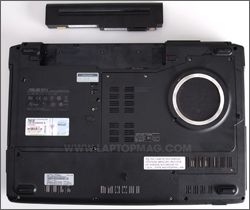Laptop Mag Verdict
This Core i7 gaming notebook gives you a lot of power and a full HD screen for a good price.
Pros
- +
Stylish design
- +
Vivid full HD screen
- +
Strong gaming performance
- +
Good value
- +
Gaming mouse and backpack included
Cons
- -
Short battery life
- -
No Blu-ray drive
- -
Mediocre Wi-Fi range
Why you can trust Laptop Mag
When it comes to playing the latest titles on a notebook, you want the best of both worlds: high frame rates and plenty of detail. The ASUS G51J-A1 delivers on both counts, thanks to its Intel Core i7 processor, Nvidia GeForce GTX 260M graphics, and full HD display. You also get 640GB of storage space. Moreover, this is a sleek system that you'll be psyched to whip out of your backpack at the next LAN party. The best part is the price; at $1,499, the G51J-A1 gives you a lot of bang for your buck.
An update to the ASUS G51Vx, the G51J-A1 sports a glossy blue lid and is adorned with a backlit ASUS Republic Of Gamers logo. There is also a light bar located on the lower portion on the lid. Taken as a whole, these touches tell you that this is a serious gaming rig.
When we lifted the lid of the 14.6 x 10.3 x 1.6-inch system, our eyes were treated to a highly attractive interior. The bezel surrounding the 15.6-inch display and the keyboard are glossy and reflective, making the system an immediate attention-grabber, though highly susceptible to fingerprints and smudges. A rubberized slip-proof (and smudge-resistant) palm rest inhabits the space below the keyboard, and has a great feel.
Above the keyboard is a speaker strip with several touch-sensitive buttons: Adjusting the gamma correction, enabling Turbo mode, disabling the touchpad, and booting into Express Gate are among the options.
Like all ASUS gaming notebooks, the G51J-A1 comes with a gaming backpack and a Razer Copperhead gaming mouse; while they may not be top-of-the-line, it's still a thoughtful inclusion.
Keyboard and Touchpad

Click to enlarge
The premium look of the G51J-A1 extends to the keyboard, where a white backlight gives each key a soft halo that can be raised or lowered through the use of the Fn and F3/F4 keys. Because the layout doesn't extend to the edges, some keys are undersized, such as the right Shift key and the numbers on the dedicated number pad. Nevertheless, the island-style keys are springy, which made for a solid typing experience.
As the G51J-A1 is designed for gamers, there are a number of gaming-specific icons scattered across the keyboard: Arrows highlight the WASD keys (which are typically used for movement), and the 1 and 6 keys are highlighted with white circles, so you can quickly tap whatever number you need to switch weapons.

Click to enlargeAbove the keyboard is a grill that houses Altec Lansing stereo speakers, and buttons that let you cycle through visual modes (Gamma Correction, Normal, Soft, Theater, Vivid), and power settings (Battery Saving, Entertainment, High Performance, Quiet Office). To the right of those are three buttons: Express Gate (ASUS' brand of the Splashtop instant-on operating system), Power, and TouchPad Enable/Disable.
The nontextured touchpad allowed us to navigate the desktop with ease. The brushed-metal mouse buttons look cool, but felt a little stiff.
Express Gate
Pressing the Express Gate button on the G51J-A1 allowed us to boot into the instant-on Linux operating system in 18 seconds and connect to the Web in another 15 seconds. The combined 33 seconds was 35 seconds shorter than the time it took to boot into the Windows 7 Home Premium operating system. We were also able to chat with friends over AIM and Skype, view photos, and listen to music while within Express Gate. This feature is nice to have, but we don't expect the target audience of gamers to use it very often.
Display and Audio
For a $1,500 system, we were pleased to see that the G51J-A1's 15.6-inch screen had a full HD resolution of 1920 x 1080 pixels. While watching Hulu videos and playing games, we noticed great colors and definition. Horizontal viewing angles were excellent--nearly 90 degrees to either side--but the screen washed out a bit when we tilted it too far back or forward.
The Altec Lansing speakers delivered excellent highs when we listened to music streamed from Pandora, but bass-heavy songs (such as Jay-Z's "Empire State of Mind") didn't have their normal thump, and sounded a bit muddy in the middle. Volume was satisfying for the most part, but when we really wanted to crank the music, we found that the speakers didn't produce very loud sound.
Ports and Webcam
Numerous ports and slots are available on the G51J-A1 for connecting accessories and peripherals. The right side of the notebook houses the 8X DVDRW drive, two USB 2.0 ports, dual headphone jacks, and a microphone jack. Given that this system has a full HD display, we would have liked to see a Blu-ray drive (or at least an option).

Click to enlarge

Click to enlarge
The left side has two more USB 2.0 ports, FireWire 400, eSATA, HDMI, VGA, and an ExpressCard/54 slot. The back of the G51J-A1 houses an Ethernet port, while the front contains a Wi-Fi on/off switch and a 6-in-1 memory card reader.
Above the display is a 2.0-megapixel webcam that we used to chat with friends in Google Video Chat. Skin tones were washed out somewhat, and we saw a little motion blur when a buddy moved too quickly, but overall the experience was good for basic Web chatting.
Performance
ASUS outfitted the G51J-A1 with 4GB of RAM and a 1.6-GHz Intel Core i7-720QM processor (which we overclocked to 2.8-GHz for our performance testing). In PCMark Vantage, which measures overall system performance, this quad-core powerhouse scored 6,001. That showing is about 540 points lower than the Alienware M15x, but is still more than 2,000 points above the desktop replacement category average.
Featuring the same Nvidia GeForce GTX 260M processor and 1GB of video memory as the M15x, the G51J-A1 did very well on our graphics tests. It scored 9,424 in 3DMark06--about 2,240 points below the M15x, but nearly 1,100 points above the Toshiba Qosmio X505, and about 2,800 points above the category average. Still, the Alienware M17x remains the champ, whose dual GTX 280M GPUs notched 13,463. In 3DMark Vantage, the G51J-A1 also had a respectable showing of 5,197 to the M15x's 5,719.
The dual 7,200-rpm, 320GB hard drives were fairly speedy, booting to Windows 7 Home Premium in 68 seconds. They also duplicated a 4.97GB folder of mixed media at a rate of 27.2 MBps. That's nearly equal with the Alienware M15x, and 2.3 MBps faster than the category average. However, the Toshiba Qosmio X505 did much better, utilizing its HDD to post a rate of 32.8 MBps.
We also tested the G51J-A1's performance by transcoding a 114MB MPEG-4 to AVI using HandBrake. Converting the file with no other open applications running in the background took 2 minutes and 57 seconds, which was 2:35 faster than the desktop replacement average. The Nvidia GeForce GTX 260M GPU inside the G51J-A1 shortened the transcode time to 2 minutes and 4 seconds when we converted the clip using vReveal, an application designed to leverage Nvidia's CUDA technology to assist in processing tasks; that's 18 seconds faster than the M15x. We performed the same task a third time using Oxelon Media Converter, a multithreaded app that takes advantage of the G51J-A1's four cores: The program finished in just 1:01.
Gaming Performance
The G51J-A1 marks one of the less expensive, but higher-performing gaming machines we've seen since the Gateway FX Series. In Far Cry 2, it averaged 99 frames per second with the resolution set to 1024 x 768, and graphics set to optimal. While that's not as high as the Alienware M15x's 113 fps, it tied the M17x, and scored 41 frames higher than its predecessor, the G51Vx. When we cranked the resolution to 1920 x 1080 and set the graphics to Very High, the G51J-A1 performed admirably once again, notching 35 fps--just 6 fps less than the M15x. While 35 fps is almost the same score as the G51Vx's 37 fps, that notebook had a top resolution of just 1366 x 768.
When it came to other games, the G51J-A1 was excellent, too. In Call of Duty: World at War, we averaged 37 fps with the resolution set to 1920 x 1080; when running through Pacific island jungles, action was smooth and crisp. We also had equal success running Left 4 Dead 2, where we had an average frame rate of 51 fps in full HD. Needless to say, the G51J-A1 handled less graphic-intensive games with ease: When playing World of Warcraft at full resolution, and with all the effects kicked to maximum, we saw a frame rate

Click to enlargeof 59 fps.
Battery Life and Wi-Fi
As this is a Core i7 gaming notebook, we didn't expect stellar endurance out of the G51J-A1. Its measly battery life of 1 hour and 15 minutes was 1:20 less than the category average, and even fell 19 minutes short of the Alienware M17x.
For a system with 802.11b/g/n Wi-Fi, throughput on the G51J-A1 was a bit on the low side. At 15 feet from our access point, we saw throughput of 18.4 Mbps, which is below the category average of 20.1 Mbps. Likewise, throughput at 50 feet--just 11.3 Mbps--fell 5.1 Mbps short of the average.
Green Testing

Click to enlarge
Not surprisingly, the G51J-A1 is very power-hungry. It took 2 hours an 2 minutes to recharge the battery--almost twice as long as its endurance--and consumed 9113.4 watts during that time. In measuring the LAPTOP Battery Efficiency Rating (total watts divided by battery life; lower is better), the G51J-A1 scored 121.5. That's well above the desktop replacement average of 67.9, and even one of the bigger power hogs to date, the Alienware M15x (117.7).
Configurations, Software, and Warranty
ASUS does not currently offer any other configurations of the G51J-A1. However, a version with a 3D display and glasses, the G51J 3D ($1,699), will be available soon. That model provides a lower-resolution panel (1366 x 768) but a more immersive gaming experience on more than 400 titles.
Besides Express Gate and Windows 7 Home Premium (64-bit), the G51J-A1 comes preinstalled with Adobe Reader 9, Microsoft Office Home and Student 2007 (60-day trial), and a number of ASUS' own programs, such as ASUS LifeFrame3 (a webcam utility) and ASUS Splendid (for video enhancement). The system is covered with a two-year global warranty and 24-7 toll-free tech support.
Verdict
If you want to blow away zombies but you're not one of the beneficiaries of a trust fund or Wall Street bonus, you'll find that the $1,499 G51J-A1 is every bit as capable as top-end rigs. The Alienware M15x offers slightly better performance and cool extras like customizable lighting, but it costs $1,874 when similarly configured to the G51J-A1. In other words, this rig is a killer value.
ASUS G51J-A1 Specs
| Bluetooth | Bluetooth 2.1 EDR |
| Brand | ASUS |
| CPU | 1.6-GHz Intel Core i7-720QM |
| Company Website | http://usa.asus.com |
| Display Size | 15.6 |
| Graphics Card | Nvidia GeForce GTX 260M |
| Hard Drive Size | Dual 320GB |
| Hard Drive Speed | 7,200rpm |
| Native Resolution | 1920x1080 |
| Operating System | MS Windows 7 Home Premium (64-bit) |
| Optical Drive | DVDRW |
| Optical Drive Speed | 8X |
| Ports (excluding USB) | Microphone, HDMI, Firewire 400, Ethernet, Dual Headphone, eSATA, VGA |
| RAM | 4GB |
| RAM Upgradable to | 8GB |
| Size | 14.6 x 10.3 x 1.6 inches |
| USB Ports | 4 |
| Video Memory | 1GB |
| Warranty/Support | Two-year global; one-year accidental; 30-Day Zero Bright Dot/24-7 toll-free phone |
| Weight | 7.3 pounds |
| Wi-Fi | 802.11b/g/n |
